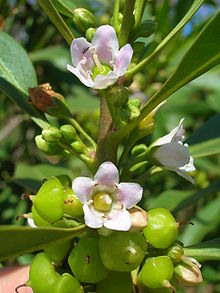- Myoporum sandwicense
-
Myoporum sandwicense 
Conservation status Not evaluated (IUCN 3.1)Scientific classification Kingdom: Plantae (unranked): Angiosperms (unranked): Eudicots (unranked): Asterids Order: Lamiales Family: Scrophulariaceae Tribe: Myoporeae Genus: Myoporum Species: M. sandwicense Binomial name Myoporum sandwicense
A.Gray[1]Myoporum sandwicense is a species of flowering tree in the figwort family, Scrophulariaceae. Common names include Naio, bastard sandalwood or false sandalwood. It is native to Hawaiʻi and Mangaia in the Cook Islands.[2]
Contents
Description
M. sandwicense grows as either a small tree, large tree, or dwarf shrub, depending on the elevation and conditions. As a small tree, it reaches a height of 9 metres (30 ft) with a trunk diameter of 0.3 metres (0.98 ft). The largest naio have a height of 18 metres (59 ft) and a trunk diameter of 0.9 metres (3.0 ft). At the tree line, naio grows as a 0.6-metre (2.0 ft) shrub.[3] The leaves are green, waxy, and typically pointed, while the bark of the naio tends to be dark gray, although the bark of one unique variety on the island of Oʻahu is covered in fine, brown hairs.[4] The flowers of M. sandwicense bloom year round and are generally white or pink and bell-shaped, with a fragrant odor[2] and a turpentine taste.[4] The fruit is a waxy white drupe that is 8 millimetres (0.31 in) in diameter, juicy, and bitter.[3] They usually dry out and remain attached to the branch.
Taxonomy
The common variety of M. sandwicense was described by Asa Gray.[5] A number of varieties exist, specifically degeneri Webster, fauriei (Levl.) Kraenzlin, lanaiense Webster, st.-johnii Webster, and stellatum Webster.[6] In addition, a prostrate, shrubby variety known as naio papa ("flat naio") grows only at South Point on the island of Hawaiʻi and is characterized by its similarities to creeping shrubs.[7]
Distribution
The distribution of M. sandwicense in the United States is limited to the state of Hawaiʻi.[5] Within the state, it is found on all of the major islands[2] at elevations from sea level to 2,380 metres (7,810 ft).[8] Naio can be found in a variety of habitats, including low shrublands, dry forests, mesic forests, and wet forests, but is most common in subalpine shrublands.[2]
Outside of the United States, M. sandwicense is also found on Mangaia in the Cook Islands.[9]
Cultivation
M. sandwicense can be cultivated using seeds separated from the fruit - the average germination time varies by reports but is most commonly noted as taking between six and eighteen months. Propagation by cuttings and air layering is also possible.[2]
Uses
The finely-textured wood of M. sandwicense is hard and has a specific gravity of 0.55.[3] Native Hawaiians, who called the wood ʻaʻaka, used it to make manu (bow and stern ornamental end pieces) and pale (gunwales) for waʻa (outrigger canoes), pou (house posts)[9], haha ka ʻupena (fishing net spacers),[8] and lamalama (long-burning torches for night fishing). The oily wood was also used as a substitute for ʻiliahi (Santalum spp.) due to the similarity in smell when burned.[4] For a short time in the 19th century after most ʻilliahi had been harvested, naio was exported to China, where it was made into incense and burned in Joss houses.[10] However, unlike true sandalwood, the wood of naio does not retain its scent for long periods, as when made into furniture.
Ecology
Currently, a large mixed māmane (Sophora chrysophylla)-naio forest on the island of Hawaiʻi serves as the home of the Palila (Loxioides bailleui), an endangered native bird.[4]
References
- ^ "Myoporum sandwicense". Germplasm Resources Information Network. United States Department of Agriculture. 2008-08-25. http://www.ars-grin.gov/cgi-bin/npgs/html/taxon.pl?24805. Retrieved 2009-02-04.
- ^ a b c d e "Myoporum sandwicense (Naio)". Hawaiian Native Plant Propagation Database. University of Hawaiʻi at Mānoa. http://www2.hawaii.edu/~eherring/hawnprop/myo-sand.htm. Retrieved 2008-03-05.
- ^ a b c Little Jr., Elbert L.; Roger G. Skolmen (1989) (PDF). Naio, false-sandalwood. United States Forest Service. http://www.ctahr.hawaii.edu/forestry/data/CommonTreesHI/CFT_Myoporum_sandwicense.pdf.
- ^ a b c d "Naio". Native Hawaiian Plants. Kapiʻolani Community College. http://old.kcc.hawaii.edu/campus/tour/plants/pnaio.htm. Retrieved 2008-03-07.
- ^ a b "PLANTS Profile for Myoporum sandwicense (Naio)". PLANTS Database. United States Department of Agriculture. http://plants.usda.gov/java/nameSearch?keywordquery=MYSAS&mode=symbol&submit.x=21&submit.y=13. Retrieved 2008-03-07.
- ^ "Myoporum sandwicense (Bastard Sandalwood, Naio, Sandal-wood)". ZipcodeZoo. http://zipcodezoo.com/Plants/M/Myoporum_sandwicense.asp. Retrieved 2008-03-07.[dead link]
- ^ Barboza, Rick (24 January 2003). "In the Garden - Naio papa". Honolulu Star-Bulletin. http://starbulletin.com/2003/01/24/features/garden.html. Retrieved 2008-03-07.
- ^ a b "naio, naeo, naieo". Hawaiian Ethnobotany Online Database. Bernice P. Bishop Museum. http://www2.bishopmuseum.org/ethnobotanydb/resultsdetailed.asp?search=naio. Retrieved 2009-03-28.
- ^ a b Medeiros, A. C.; C.F. Davenport; C.G. Chimera (1998) (PDF). Auwahi: Ethnobotany of a Hawaiian Dryland Forest. Cooperative National Park Resources Studies Unit, University of Hawaiʻi at Mānoa. http://www.hear.org/naturalareas/auwahi/ethnobotany_of_auwahi.pdf.
- ^ Thrum, Thomas George (1891). The Hawaiian Annual and Almanac. Honolulu, Hawaiʻi: Star-Bulletin Printing Co. p. 93. http://books.google.com/?id=2uwKAAAAIAAJ.
External links
- "Naio". Native Hawaiian Plants. Kapiʻolani Community College. http://old.kcc.hawaii.edu/campus/tour/plants/pnaio.htm.
- Myoporum sandwicense (naio) information from the Hawaiian Ecosystems at Risk project (HEAR)
- Myoporum sandwicense (naio) images from Forest & Kim Starr
Categories:- Myoporum
- Trees of Hawaii
- Flora of Polynesia
Wikimedia Foundation. 2010.
